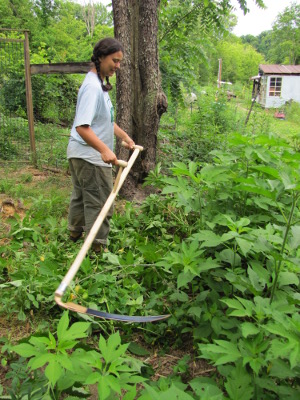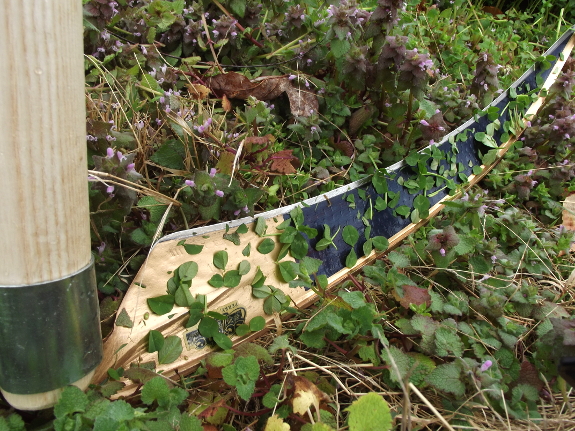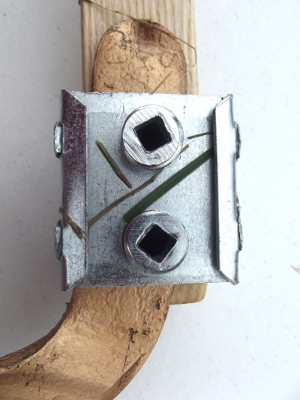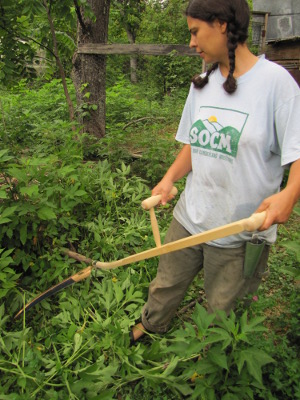
When to use a scythe
 A lot of people buy an Austrian
scythe because they want to replace their weedeater and/or
lawnmower with a hand tool. Why use gasoline when you don't have
to?
A lot of people buy an Austrian
scythe because they want to replace their weedeater and/or
lawnmower with a hand tool. Why use gasoline when you don't have
to?
Although I agree with
that logic to some extent, Mark has turned me into a realist when it
comes to homesteading tools. If a hand tool takes a significant
amount more muscle than a power tool, I might choose the power tool.
On the other hand, I
also factor in the long term effort involved. If I'm afraid of
the power tool, can't get it started easily, or can't fix common
ailments myself, I might find it simpler in the long run to use a hand
tool. That's why our
tool kit contains a mixture of power and hand tools, into which the scythe slid
gracefully.
So which power tools
does the scythe replace, and when? Pros use their scythe to mow
the lawn, but I have to admit that I find the lawnmower much easier in
that respect. On the other hand, the scythe is great on rough
terrain or when cutting tall weeds that would bog down the mower.
There, Mark would turn to the weedeater, but that tool fails all
three of my power tool tests, so I stick to the scythe. (Despite
being scared of the weedeater, I wouldn't try to use my scythe for the
tasks Mark turns his ninja
blade to --- really
heavy duty brush is a job either for power tools or for slow and steady
work with loppers and a hand saw.)

 Even if you like your
weedeater, you might find a scythe handy in certain situations.
Scythes cut right where you tell them to without shredding the severed
plant to bits, so they're great for harvesting grain and cutting
comfrey for mulch.
My scythe also makes it easy to mow with more discernment, a boon in my
complicated forest gardens and pastures, where I might want to leave a
berry plant to finish fruiting, mow red clover at six inches but
ragweed right at the ground, and be able to feel that I'm hitting a
fallen branch before damaging my tool.
Even if you like your
weedeater, you might find a scythe handy in certain situations.
Scythes cut right where you tell them to without shredding the severed
plant to bits, so they're great for harvesting grain and cutting
comfrey for mulch.
My scythe also makes it easy to mow with more discernment, a boon in my
complicated forest gardens and pastures, where I might want to leave a
berry plant to finish fruiting, mow red clover at six inches but
ragweed right at the ground, and be able to feel that I'm hitting a
fallen branch before damaging my tool.
(I can't say for sure
that a weedeater can't do all those things --- I've hardly used
one. But I can tell you for sure that it's easier for me to
scythe my complex pastures than to explain to Mark how I want them cut.)
Now for the downsides of
the scythe. You need to commit more time to learning the craft,
paying special attention to sharpening the blade. On the other
hand, while you can just start a weedeater and let her rip, you'll
still have to take the tool in for a tuneup from time to time if you
can't figure out how to clean the air filter, change the spark plug,
etc.  In the long run, I think that
a scythe requires less knowledge to keep the tool running at its best
than a weedeater does, unless you're already an expert at small engine
repair.
In the long run, I think that
a scythe requires less knowledge to keep the tool running at its best
than a weedeater does, unless you're already an expert at small engine
repair.
I was also disappointed
to discover that scything is very wrist intensive. I'm prone to
carpal tunnel flareups, which is why Mark splits all the wood around
here. While not nearly as bad for my tendons as splitting wood,
half an hour of scything is really all my wrists can handle before they
begin to protest. This is a problem because scything is extremely
addictive and fun, and it's hard to make myself stop once I've started!
I'm sure I'll discover
additional pros and cons of the scythe as I use it more. I
haven't quite put in the eight hours required before I need to peen the
blade yet, so take my advice with a grain of salt. Maybe other
scythe-users will chime in with the times they choose to (and not to)
use their scythe.
Want more in-depth information? Browse through our books.
Or explore more posts by date or by subject.
About us: Anna Hess and Mark Hamilton spent over a decade living self-sufficiently in the mountains of Virginia before moving north to start over from scratch in the foothills of Ohio. They've experimented with permaculture, no-till gardening, trailersteading, home-based microbusinesses and much more, writing about their adventures in both blogs and books.
Want to be notified when new comments are posted on this page? Click on the RSS button after you add a comment to subscribe to the comment feed, or simply check the box beside "email replies to me" while writing your comment.

I love my Austrian scythe! I also got a fairly short blade, because I use it to mow rather tall grass and blackberry canes.
One of the things that takes practice is swinging it with good posture. I often find my right arm starting to ache because I am holding the scythe off the ground. If I relax my arms and let them hang straight, it really helps. If you have a copy of "The Scythe Book," read his section about posture. It helps that I am already familiar with the Alexander posture technique that he mentions.
I also noticed recently that if I allow my left arms to do some of the work (balance the work between both arms) that helps. And it helps to use the motion of your body to swing it.
I am still an amateur, so perhaps there are some other mowers who could contribute suggestions. I do love my scythe, for the same reasons as you. It's great for clearing tall weeds, although I still haven't gotten the trick of mowing clumpy grass with it. (The kind of grass that makes little hillocks.)
The other reason I have it is that I'm in the middle of a land purchase negotiation (wow! nerve-racking) and I am hoping that if I can get the land, I can do some small grain growing.
Speaking of which, I would love to see a post about what small grains you would consider growing in the Appalachians. (You are in the Apps, right?) I want to grow winter wheat using the Marc Bonfils method (related to the methods of Masanobu Fukuoka) but I am told that our climate is too humid for wheat.
Faith --- I'm still working my way through the Scythe Book, but do remember enjoying his section on the Alexander technique. (I'd heard of it before, but never seen it explained.) Unfortunately, I don't think posture is going to help my wrists --- just closing my hand solidly around something for an extended period of time is enough to inflame my carpal tunnel. I probably could rig some kind of brace that fits over my forearm and prevents me from having to grip if I really needed to use the scythe for longer, but I'm not that desperate.
I had the same problem you did with clumpy grass. Luckily, we only have five or six plants around the garden, so I'm just digging them up one by one....
We're in the infancy of learning about grains. We didn't have much luck with wheat, but our neighbors seem to do well with barley and rye (and maybe oats as a summer crop?) Field corn, of course, is the most productive and easiest to grow, but it doesn't make straw and isn't grown like other grains.
Can you point me to a book about the Marc Bonfils method? I'm very interested in a more sustainable way of growing grain, and while Fukuoka's books are interesting, they need a lot of tweaking to fit our climate.
Sarah --- I got a copy of The Scythe Book with my scythe and have been slowly reading through it. It helps to read the book a bit at a time, practicing in between. People who like watching instead of reading have turned to youtube, where there are apparently a lot of instructional videos. Good luck!
Regarding Marc Bonfils - when I google him now, I immediately come across references to "The Harmonious Wheatsmith." But when I first learned about him, it was through vague references to a pamphlet... hardly any real information.
Essentially, he uses winter wheat that sends out a lot of side shoots - so many side shoots that the plant gets to be a foot across. He plants it on the summer solstice, staggered at 2 ft intervals, with clover between. Then next summer solstice, he plants new wheat in the foot intervals between. Then he harvests the first (mature) plants in August. So this allows for a continuous cycle.
Faith --- Thanks for such a succinct sumup! I was just reading various things about him on the internet and your analysis seems to summarize it all up perfectly.
What I'm going to have to figure out, unfortunately, before I give it a try, is how to turn the powerline cut (full of stumps and high weeds) into a growing area without tilling it. It's too big to kill mulch all at once, but I could poke at it slowly but surely. Or maybe just scythe until things scale back down. Hmmm....
I am also pretty new at this, have not had to peen my blades yet. I got a 28" grass blade and a 24" ditch blade, thinking those will cover most of my needs. When I have heavier stuff, it is usually time to break out the digging bar and bush axe, etc.
I have not found any reasons to go back. I have been wanting to stop using the lawn mower for a while, because I feel it creates many unsustainable external dependencies and provides absolutely no benefits. I don't need a golf course or a soccer field, and there are better ways to create walkable paths. When I determine I am putting too much time into scythe mowing, the conclusion I come to is not "I need a gas mower", but "I have too much grass".
Before I got my scythe, I was paying for: - mower gas - mower maintenance - straw (likely from GMO plants sprayed with herbicides) - compost mix (also likely to be contaminated)
Now I avoid all those costs by using my scythe to mow and find uses for all the biomass it produces.
While it is true that mowing with a scythe takes longer than a gas powered mower, I reckon I spend less time mowing overall because now I mow much less frequently. Gas mowers don't function well when the grass gets tall, but the scythe works like a charm whenever I feel like using it.
There isn't much to be done about your wrist issue other than what you are doing - don't mow for more than you can stand. Those short breaks to whet the blade are helpful to prevent fatigue.
As you pointed out, using the scythe puts us in a much better position to choose what we mow or leave. My honeybees and other pollinators like flowers, my chickens and other birds like seeds, and I prefer my straw mulch long as well. I usually leave clover and other N-fixers as well as dynamic accumulators, because taller plants mean longer roots and more delicious soil.
I am also keen to learn more about small scale grains - making my way through "Small Scale Grain Raising" by Gene Logsdon now. I am also very interested in Bonfils, as well as the research of Wes Jackson at The Land Institute on the development (by cross breeding existing stock, not GM) of perennial grain crops.
I seem to remember that Bonfils had a method of bringing a meadow into wheat cultivation. Something about mowing (with a scythe) at the right intervals during that first summer when the wheat is fairly short. You would want to read the information available online.
And the real question is, can you effectively grow wheat where you live? A good friend of mine (who is an excellent gardener) has warned me that our mountains near Asheville are too humid for wheat. Although he mentioned in passing that some people have made strides with special varieties of wheat; I do not know if those varieties would work well in Bonfils's method.
Chris --- I totally agree. I think the scythe is a prime permaculture tool because it makes it easy to cut your own mulch from whatever is growing around you, which opens up a lot of possibilities beyond lawn. You might enjoy the chapter Mowing in Lee Reich's The Pruning Book since he uses a similar scything method to create "Lawn Nouveau".
Faith --- I definitely wouldn't try wheat. As I mentioned earlier, we tried it before without much luck. Barley and rye seem to do better locally.
We might have to mow that area for a year or two before it even reaches the meadow stage, but it's good to hear that if we can get there, we can probably convert to grain no-till!
Anna,
One of the obvious times to use the scythe (for us anyway, here in overcrowded Japan) is very early morning. If I'm out at five in the morning on a Sunday (quite likely, now that the summer heat and humidity have arrived), then I can quite happily put in a couple of hours of mowing without worrying too much about waking the non-farming neighbours in the vicinity.
Clumped grass... the best method I've found to date is a drastic change in technique, from an easy swing to a power stroke (really put more upper-body energy into it) and, at the same time, pull back sharply towards you with the left arm (for right-handers). Don't be afraid to circle round the clump and cut again from a different direction to get those left-over blades of grass that always seem to be slumped over on your side of the clump.
Back ache... for me, using the scythe is actually beneficial. The relatively static lower body and the gentle swing of the upper seems to loosen up my spine and back muscles.
When not to use the scythe? We have some really steep slopes surrounding some of our land (think rice paddies on hill sides) which are also very stony. Using the scythe on these slopes is positively dangerous (actually, using just about any tool on those slopes is dangerous), with the added problem of not just blunting, but damaging the blade on those hidden stones. The weed-whacker is still a pain to use, but a lot less likely to send you skidding down the slope on your rump, plus replacement blades are available just about everywhere.
As a side note... I spent a few minutes a couple of weekends back introducing my (adult) daughter to the scythe when she was here on a visit. It was interesting to see her progress as she went from the initial limp swings ("This thing is heavy!") to a more coordinated, parallel cut in about ten to fifteen minutes. There was a certain point where she started (subconciously, I think) making slight changes to angle and swing to suit the vegetation (we were working over some very rough, mixed terrain), where it was obvious that she "got it" and it very suddenly came together for her. I seem to remember, in the very, very distant past, digging holes in the dirt and generally being a danger to dogs and co-workers for what seemed like weeks while I got the hang of scything. How about everyone else? How long was it before you felt reasonably competent?
John --- When I started reading your comment, I just figured you were our regular commenter from Japan. Exciting to have two of you commenting!
Excellent information! I was thinking of using the scythe on our steep powerline cut, but maybe I should hold off....
I still don't feel like I'm all that good at scything after maybe four to six hours (spread across a month or two ), but I do feel like I've gotten past the stage where I spend all of my time pondering the exact body movements. That happened for me maybe an hour or so in?
), but I do feel like I've gotten past the stage where I spend all of my time pondering the exact body movements. That happened for me maybe an hour or so in?
Thanks to this blog topic, I ordered and received a European or Austrian scythe with a grass blade a couple of days ago. I have had really bad luck with gas lawn mowers and since I can't do engine work myself, I have had to both pay to have them repaired a lot, and for 2 years paid to have my grass mowed. I also live on the side of a pretty steep hill and pushing a mower is not pleasant. I love the scythe! It is so easy for me to use and I am a 48 year old woman without tons of strength nor energy. Mowing the grass used to leave me completely wrung out and part of that was waiting til the sun had dried the grass when it was hot. I scythed in the morning when it was still cool and the grass was wet and it was not at all tiring for me. There was no bending since I had it sized for me. I had concerns about using it on the hill, but it is no problem at all. It is so light that I am not calling on upper body strength that I really don't have. So I am saving money on mower repairs and on gas, and love that I am not adding to pollution.
Thanks, Anna, for the idea!
I know this topic is old but it's worth bringing back! Weeks ago, I spent $131 on an aluminum U.S.A. made snath (with wood nibs), and an "Austrian" blade at the local gardening store. It was awful! Heavy, very difficult to adjust the nibs, and the snath was way too short for me. The nibs were so difficult to adjust that using channel locks was the only way to loosen them which resulted in damaging the wood! Once I repositioned the nibs (and scratched the aluminum), the whole tool was way off balance and even more awkward to work with.
I quickly ordered a real scythe and the results have been beyond my expectations! I purchased an Italian blade (65cm) and an ash snath. The whole thing was so easy to assemble and the nibs were easy to adjust as I found the right position and balance to suit me. I became comfortable with it after only one hour of use. Yesterday, I forgot to bring my work gloves to a site where I was clearing a hiking trail. I was quite far from home and was not about to turn back to get them. After FOUR hours of mowing tall, heavy brush with my scythe, I have NO blisters or hot spots on my hands whatsoever! I am a huge fan of the scythe...as long as it's the right scythe! I'm afraid anyone who purchases one like my first one will be VERY disappointed and may give up on the idea of scything completely. What a shame that would be! Scytheconnection.com is a fantastic site and should be read thoroughly before putting any amount of money down on a new scythe. Having the right tool can mean the difference between total misery and pure joy!